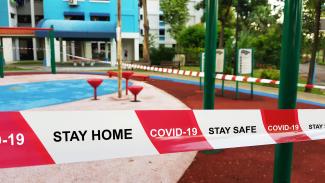
“Singapore cannot stay locked down and closed off indefinitely. It would not work, and it would be very costly.”, said Singapore Prime Minister Lee Hsien Loong in October 2021 during his national address on the COVID-19 situation.
In January 2020, Singapore set up its Multi-Ministry Taskforce (MTF) to spearhead and organise the national response to the COVID-19 pandemic. Its challenge was to strike a balance between preserving lives and ensuring that livelihoods were not affected drastically.
During the early days of the pandemic, Singapore’s strict and systematic approach to testing and surveillance was lauded as a “gold standard of near-perfect detection”. However this was followed by a rising discontent with the soaring infections during the Delta variant wave in mid-2021 and accompanying rising number of deaths among the elderly, on top of the frustration mounting from the numerous restrictions, protocols, and the constant changes of proclaimed “phases” aimed at managing the spread of the COVID-19 virus in the community. Perceived discrimination had also arisen from the segmented access according to the vaccination status of individuals.
Amid the multitude of challenges accompanied by the Delta wave, the Singapore government declared a bold move to shift towards a new phase of living with the virus. Instead of treating COVID-19 as a deadly disease to be stopped at all costs, the country would begin to manage it more like a common infliction, like influenza and chicken pox. This move to go endemic was viable as more than 80% of the population had been vaccinated by early August that year.
The transition to COVID-19 resilience started with the easing of safe management measures from 10 August 2021, followed by the loosening of healthcare protocols and rules on social activities and travel. Resting and recovering at home became the default treatment for COVID-19 cases provided that infected individuals met several criteria. As part of the move, the MTF cautioned that the country had to be prepared for the imminent rise in infections, and also serious cases which required intensive hospital care.
However, the rise in cases was higher and faster than anticipated, which put considerable strain on the national healthcare capacity. Coupled with new evidence that the efficacy of mRNA vaccines waned over time and the challenges of the Home Recovery Programme, the MTF had to adapt its original roadmap. A third vaccination or booster programme was rolled out for seniors in September 2021, fresh restrictions to curb infections were implemented, and testing and isolation protocols were also simplified.
Throughout the fight against the virus and during the transition to a COVID-19 resilient society, the Singapore government was faced with the tasks of protecting lives, maintaining the national healthcare capacity, and allowing daily livelihoods to resume, while not raising false hopes nor causing an undue sense of doom and gloom at the same time.
Public health analyst David Chong attempts to assess the performance of Singapore’s endemic strategy in October 2021. To what extent could this strategy be considered effective by then? What lessons could be gleaned from the country’s efforts? Which areas did it do well, and which aspects could it have done better?
The case, “Living with the Virus: Singapore’s 2021 Endemic Strategy in the COVID-19 Pandemic” is written by Tan Chin Tiong, Professor Emeritus of Marketing at the Lee Kong Chian School of Business, Singapore Management University, Dr. Lim Tow Keang, Professor at the National University Hospital, Dr. Wee-Kiat Lim, Associate Director at the Centre for Management Practice and Dr. Jovina Ang of Singapore Management University. To read it in full, please visit the CMP website by clicking here.